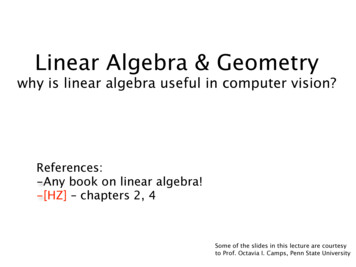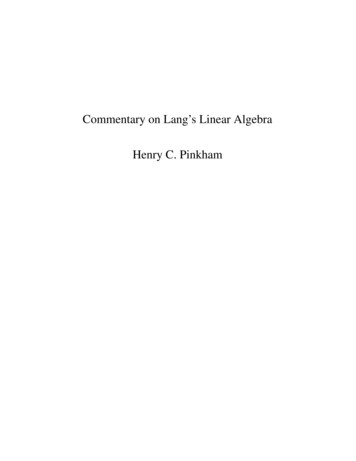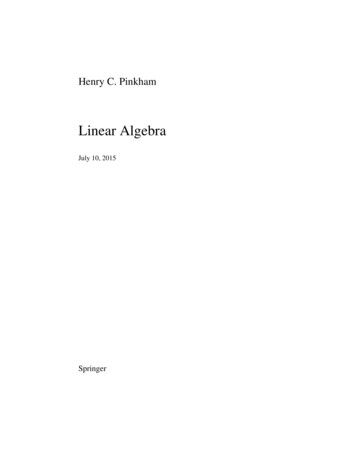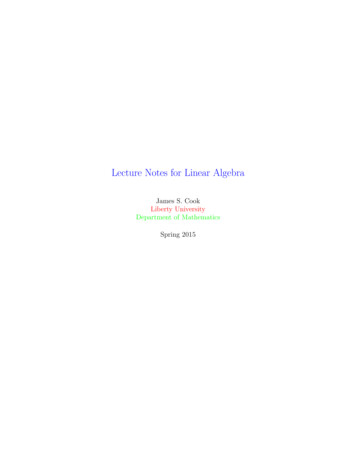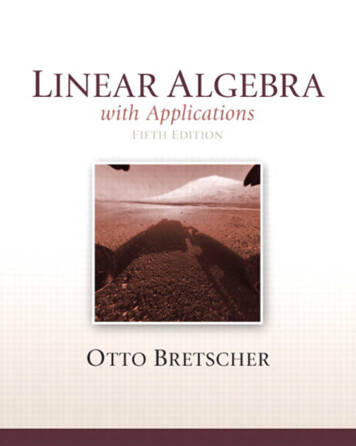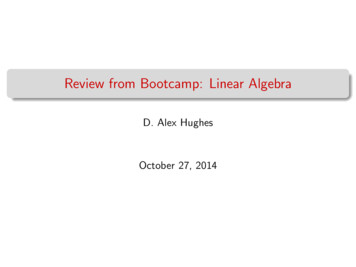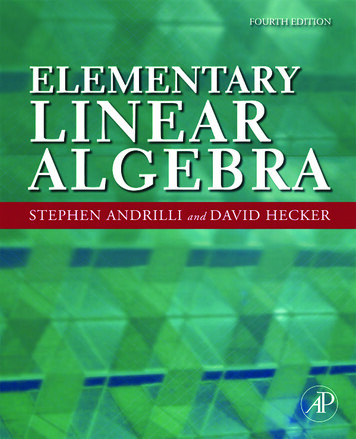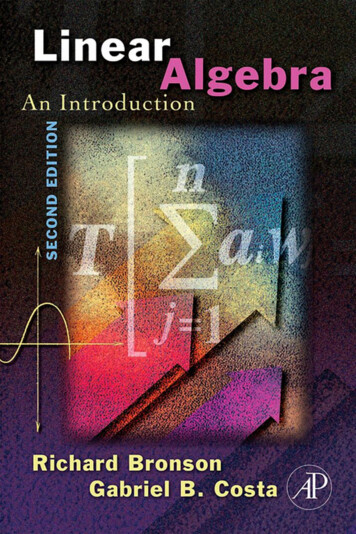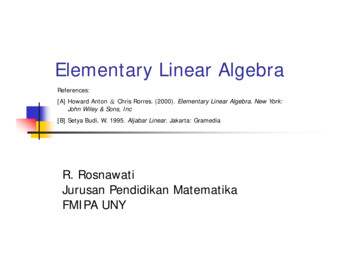
Transcription
Elementary Linear AlgebraReferences:[A] Howard Anton & Chris Rorres. (2000). Elementary Linear Algebra. New York:John Wiley & Sons, Inc[B] Setya Budi, W. 1995. Aljabar Linear. Jakarta: GramediaR. RosnawatiJurusan Pendidikan MatematikaFMIPA UNY
Chapter Contents 1.1 Introduction to System of LinearEquations1.2 Gaussian Elimination1.3 Matrices and Matrix Operations1.4 Inverses; Rules of Matrix Arithmetic1.5 ElementaryMatrices and a Method forA 1Finding1.6 Further Results on Systems ofEquations and Invertibility
1.1 Introduction toSystems of Equations
Linear Equations Any straight line in xy-plane can berepresented algebraically by an equation ofthe form:a1x a2 y b General form: define a linear equation in the nvariables x1 , x2 ,., xn :a1x1 a2x2 . anxn b Where a1 , a 2 ,., a n , and b are real constants.The variables in a linear equation are sometimescalled unknowns.
Example 1Linear Equations 1The equations x 3 y 7, y x 3 z 1, andx1 2x2 3x3 x4 7 are linear. 2Observe that a linear equation does not involve anyproducts or roots of variables. All variables occur only tothe first power and do not appear as arguments fortrigonometric, logarithmic, or exponential functions.The equations x 3 y 5, 3x 2y z xz 4, and y sinxare not linear. A solution of a linear equation is a sequence of n numberss1 , s2 ,., sn such that the equation is satisfied. The set ofall solutions of the equation is called its solution set orgeneral solution of the equation
Example 2Finding a Solution Set (1/2) Find the solution of(a ) 4 x 2 y 1Solution(a)we can assign an arbitrary value to x and solve for y ,or choose an arbitrary value for y and solve for x .Ifwe follow the first approach and assign x an arbitrary11value ,we obtain x t , y 2t 1orx t , y t21122 2arbitrary numbers t1, t 2 are called parameter.for example11t1 3 yields the solution x 3, y 24as t 2 112
Example 2Finding a Solution Set (2/2) Find the solution of (b) x1 4 x2 7 x3 5.Solution(b)we can assign arbitrary values to any twovariables and solve for the third variable. for examplex1 5 4s 7t , x2 s ,x3 twhere s, t are arbitrary values
Linear Systems (1/2) A finite set of linear equations inthe variables x 1 , x 2 ,., x na11x1 a12 x2 . a1n xn b1is called a system of lineara21x1 a22 x2 . a2n xn b2equations or a linear system .A sequence of numberss1 , s 2 ,., s n is called a solutionof the system.A system has no solution is saidto be inconsistent ; if there is atleast one solution of the system,it is called consistent. am1x1 am2 x2 . amn xn bmAn arbitrary system of mlinear equations in n unknowns
Linear Systems (2/2) Every system of linear equations has eitherno solutions, exactly one solution, orinfinitely many solutions.A general system of two linear equations:(Figure1.1.1) a1 x b1 y c1 ( a1 , b1 not both zero)a2 x b2 y c2 (a2 , b2 not both zero) Two lines may be parallel - no solutionTwo lines may intersect at only one point- one solutionTwo lines may coincide- infinitely many solution
Augmented Matrices The location of the ’s,the x’s, and the ‘s canbe abbreviated by writingonly the rectangular arrayof numbers.This is called theaugmented matrix for thesystem.Note: must be written inthe same order in eachequation as the unknownsand the constants must beon the right.a11 x1 a12 x2 . a1n xn b1a21 x1 a22 x2 . a2 n xn b2 am1 x1 am 2 x2 . amn xn bm1th column a11 a12 . a1n b1 a a . a b2n2 21 22 aa.abmnm m1 m 21th row
Elementary Row Operations The basic method for solving a system of linear equations is toreplace the given system by a new system that has thesame solution set but which is easier to solve.Since the rows of an augmented matrix correspond to theequations in the associated system. new systems is generallyobtained in a series of steps by applying the following threetypes of operations to eliminate unknowns systematically. Theseare called elementary row operations.1. Multiply an equation through by an nonzero constant.2. Interchange two equation.3. Add a multiple of one equation to another.
Example 3Using Elementary row Operations(1/4)x y 2z 92 x 4 y 3z 13x 6 y 5 z 0 1 1 2 9 2 4 3 1 3 6 5 0 add - 2 timesthe first equationto the secondx y 2z 2 y 7 z 1 7 3x 6 y 5z add - 2 timesthe first rowto the second 90add -3 timesthe first equationto the third 9 1 1 2 0 2 7 17 3 6 5 0 add - 3 timesthe first rowto the third
Example 3Using Elementary row Operations(2/4)add - 3 timesx y 2 z 9 multiply the second x y 2 z 91the second equation717equationbyy 2 z 22 y 7 z 17to the third2 3 y 11z 273 y 11z 0multily the second9 add -3 times9 1 1 2 1 1 21 0 2 7 17 0 1 7 17 the second rowrow by22 2 to the third 0 3 11 27 0 3 11 27
Example 3Using Elementary row Operations(3/4)x y 2z 9Multiply the thirdequation by - 2x y 2z 9y 72 z 172 y 72 z 172z 3 12 z 32 1 1 2 0 1 72 0 0 129 172 32 Multily the thirdrow by - 2 1 1 2 0 1 72 0 0 1Add -1 times thesecond equationto the first 9 Add -1 times the 172 second rowto the first 3
Example 3Using Elementary row Operations(4/4)x 112z 352y 72 z 172z 1 0 112 701 2 0 0 13 3 352172Add - 112 timesthe third equationto the first and 72 timesthe third equationto the secondAdd - 11times2the third rowto the first and 72times the third rowto the second xy 1 2z 3 1 0 0 1 0 1 0 2 0 0 1 3 The solution x 1,y 2,z 3 is now evident.
1.2 Gaussian Elimination
Echelon FormsThis matrix which have following properties is in reduced rowechelon form1. If a row does not consist entirely of zeros, then the firstnonzero number in the row is a 1. We call this a leader 1.2. If there are any rows that consist entirely of zeros, then they aregrouped together at the bottom of the matrix.3. In any two successive rows that do not consist entirely of zeros,the leader 1 in the lower row occurs farther to the right than theleader 1 in the higher row.4. Each column that contains a leader 1 has zeros everywhere else. A matrix that has the first three properties is said to be in rowechelon form (Example 1, 2). A matrix in reduced row-echelon form is of necessity in rowechelon form, but not conversely.
Example 1Row-Echelon & Reduced Row-Echelon form reduced row-echelon form: 0 1 0 0 4 1 0 0 0 1 0 7 , 0 1 0 , 0 0 0 0 1 1 0 0 1 0 1 2 0 1 0 0 1 3 0 0 , 0 0 0 0 0 0 0 0 0 0 row-echelon form: 1 4 3 7 1 1 0 0 1 2 6 0 0 1 6 2 , 0 1 0 , 0 0 1 1 0 0 0 1 5 0 0 0 0 0 0 0 1
Example 2More on Row-Echelon and ReducedRow-Echelon form 1 0 0 0 1 0 0 0All matrices of the following types are in row-echelonform ( any real numbers substituted for the *’s. ) :*100* 1* 0,* 0 1 0**10*100* 1* 0,* 0 0 0**10*100**00 0* 0* , 00 00 01000*000*100**10***1****000000* * * * 0 1 * ********All matrices of the following types are in reduced rowechelon form ( any real numbers substituted for the *’s. ) :010000100 10 0,0 0 1 001000010* 1* 0,* 0 0 00100**00 0* 0* , 0 0 00 010000*0000010000010000010****0****000001* * * * *
Example 3Solutions of Four Linear Systems (a)Suppose that the augmented matrix for a system oflinear equations have been reduced by row operations tothe given reduced row-echelon form. Solve the system. 1 0 0 5 (a) 0 1 0 2 0 0 1 4 Solution (a)the corresponding systemof equations is : 5xy -2z 4
Example 3Solutions of Four Linear Systems (b1) 1 0 0 4 1 (b) 0 1 0 2 6 0 0 1 3 2 Solution (b)1. The correspondingsystem of equations is : 4 x4 - 1x1x2 2 x4 6x3 3 x4 2leadingvariablesfree variables
Example 3Solutions of Four Linear Systems (b2)x1 - 1 - 4 x 4x2 6 - 2 x4x3 2 - 3 x42. We see that the free variable can beassigned an arbitrary value, say t, whichthen determines values of the leadingvariables.3. There are infinitely manysolutions, and the generalsolution is given by theformulasx1 1 4 t ,x2 6 2t ,x 3 2 3t ,x4 t
Example 3Solutions of Four Linear Systems (c1) 1 0(c) 0 06 0 040 1 030 0 150 0 0 0 2 1 2 0 Solution (c)1. The 4th row of zeros leads tothe equation places norestrictions on the solutions(why?). Thus, we can omitthis equation.x1 6 x2 4 x5 - 2x3 3 x5 1x4 5 x5 2
Example 3Solutions of Four Linear Systems (c2)Solution (c)2. Solving for the leadingvariables in terms of the freevariables:3.The free variable can beassigned an arbitraryvalue,there are infinitelymany solutions, and thegeneral solution is given bythe formulas.x1 - 2 - 6 x2 - 4 x5x3 1 - 3x5x4 2 - 5 x5x1 - 2 - 6 s - 4 t ,x2 sx 3 1 - 3tx 4 2 - 5t ,x4 t
Example 3Solutions of Four Linear Systems (d) 1 0 0 0 (d) 0 1 2 0 0 0 0 1 Solution (d):the last equation in the corresponding system ofequation is0 x1 0 x 2 0 x 3 1Since this equation cannot be satisfied, there isno solution to the system.
Elimination Methods (1/7) We shall give a step-by-step eliminationprocedure that can be used to reduce anymatrix to reduced row-echelon form. 0 0 2 0 7 12 2 4 10 6 12 28 2 4 5 6 5 1
Elimination Methods (2/7) Step1. Locate the leftmost column that does not consistentirely of zeros. 0 0 2 0 7 12 2 4 10 6 12 28 2 4 5 6 5 1 Leftmost nonzero columnStep2. Interchange the top row with another row, tobring a nonzero entry to top of the column found in Step1. 2 4 10 6 12 28 0 0 2 0 7 12 2 4 5 6 5 1 The 1th and 2th rows in thepreceding matrix wereinterchanged.
Elimination Methods (3/7) Step3. If the entry that is now at the top of the columnfound in Step1 is a, multiply the first row by 1/a in order tointroduce a leading 1. 1 2 5 3 6 14 0 0 2 0 7 12 2 4 5 6 5 1 The 1st row of the precedingmatrix was multiplied by 1/2.Step4. Add suitable multiples of the top row to the rowsbelow so that all entires below the leading 1 become zeros.14 1 2 5 3 6 0 0 2 0 7 12 0 0 5 0 17 29 -2 times the 1st row of thepreceding matrix was added tothe 3rd row.
Elimination Methods (4/7) Step5. Now cover the top row in the matrix and beginagain with Step1 applied to the submatrix that remains.Continue in this way until the entire matrix is in rowechelon form.14 1 2 5 3 6 0 0 2 0 7 12 0 0 5 0 17 29 14 1 2 5 3 6 0 0 1 0 7 6 2 0 0 5 0 17 29 Leftmost nonzerocolumn in the submatrixThe 1st row in the submatrixwas multiplied by -1/2 tointroduce a leading 1.
Elimination Methods (5/7) Step5 (cont.) 1 2 5 3 6 14 0 0 1 0 7 6 2 1 0 0 0 0 21 1 2 5 3 6 14 0 0 1 0 7 6 2 0 0 0 0 12 1 1 2 5 3 6 14 0 0 1 0 7 6 2 0 0 0 0 1 2 -5 times the 1st row of thesubmatrix was added to the 2ndrow of the submatrix to introducea zero below the leading 1.The top row in the submatrix wascovered, and we returned again Step1.Leftmost nonzero column inthe new submatrixThe first (and only) row in thenew submetrix was multipliedby 2 to introduce a leading 1. The entire matrix is now in row-echelon form.
Elimination Methods (6/7) Step6. Beginning with las nonzero row and working upward, addsuitable multiples of each row to the rows above to introducezeros above the leading 1’s. 1 2 5 3 6 14 7/2 times the 3rd row of the 0 0 1 0 0 1 preceding matrix was added to the 2nd row. 0 0 0 0 1 2 1 2 5 3 0 2 0 0 1 0 0 1 0 0 0 0 1 2 1 2 0 3 0 0 0 1 0 0 0 0 0 0 1 The last matrix-6 times the 3rd row was addedto the 1st row.7 5 times the 2nd row was added1 to the 1st row.2 is in reduced row-echelon form.
Elimination Methods (7/7) Step1 Step5: the above procedure produces arow-echelon form and is called Gaussianelimination.Step1 Step6: the above procedure produces areduced row-echelon form and is called GaussianJordan elimination.Every matrix has a unique reduced rowechelon form but a row-echelon form of a givenmatrix is not unique.
Example 4Gauss-Jordan Elimination(1/4) Solve by Gauss-Jordan Eliminationx1 3 x2 2 x3 2x 5 02 x1 6 x2 5 x3 2 x4 4 x5 3 x6 15 x3 10 x42 x1 6 x2 15 x6 5 8 x4 4 x5 18 x6 6Solution:The augmented matrix for the system is 1 2 0 23-20206-5-24-305100156084180 - 1 5 6
Example 4Gauss-Jordan Elimination(2/4) Adding -2 1 3 0 0 0 0 0 0times the-20-1 - 25 10481st2000row to the 2nd and 4th rows gives00 - 3 - 1 155 186 Multiplying the 2nd row by -1 and then adding -5 times thenew 2nd row to the 3rd row and -4 times the new 2nd rowto the 4th row gives 1 3 - 2 0 2 0 0 0 0 1 2 0 - 3 1 0 0 0 0 0 0 0 0000062
Example 4Gauss-Jordan Elimination(3/4) Interchanging the 3rd and 4th rows and then multiplying the 3rdrow of the resulting matrix by 1/6 gives the row-echelon form.0200 1 3 - 2 0 0 - 1 - 2 0 - 3 - 1 1 0 0 00013 0000000 Adding -3 times the 3rd row to the 2nd row and then adding 2times the 2nd row of the resulting matrix to the 1st row yields thereduced row-echelon form. 1 3 0 4 2 0 0 0 0 1 2 0 0 0 0 0 0 0 0 1 13 0000000
Example 4Gauss-Jordan Elimination(4/4) The corresponding system of equations isx1 3 x2 4 x4 2 x 5 0x3 2 x4 0x6 13 SolutionThe augmented matrix for the system isx1 3 x2x3 2 x4x6 4 x4 2x513We assign the free variables, and the general solution isgiven by the formulas:x1 3r 4 s 2t , x 2 r , x3 2 s , x 4 s , x5 t , x6 13
Back-Substitution It is sometimes preferable to solve a system of linearequations by using Gaussian elimination to bring theaugmented matrix into row-echelon form withoutcontinuing all the way to the reduced row-echelonform.When this is done, the corresponding system of equationscan be solved by solved by a technique called backsubstitution.Example 5
Example 5ex4 solved by Back-substitution(1/2) From the computations in Example 4, a row-echelon form fromthe augmented matrix is 1 0 0 0 3000- 2-1000- 20020000-3100 - 1 1 3 0 To solve the corresponding system of equationsx1 3x2 4x4 2x5 0x3 2x4 0x6 13Step1. Solve the equations for the leading variables.x1 3 x2x3 1 2 xx6 13 2 x43 3 x 2 x65
Example5ex4 solved by Back-substitution(2/2) Step2. Beginning with the bottom equation and working upward,successively substitute each equation into all the equations above it. Substituting x6 1/3 into the 2nd equationx1 3 x 2 2 x 3 2 x 5x3 2 x4x 6 13Substituting x3 -2 x4 into the 1st equationx1 3 x 2 2 x 3 2 x 5x3 2 x4x6 13Step3. Assign free variables, the general solution is given by theformulas.x1 3 r 4 s 2 t , x 2 r , x 3 2 s , x 4 s , x 5 t , x 6 13
Example 6Gaussian elimination(1/2) Solvex y 2z 92 x 4 y 3z 13x 6 y 5 z 0by Gaussian elimination andback-substitution. (ex3 of Section1.1)Solution We convert the augmented matrix to the ow-echelon form 1 2 31462 3 5 1 0 01210The system corresponding to this matrix is 1729 1 0 9 172 3 x y 2 z 9, y 72 z 172 , z 3
Example 6Gaussian elimination(2/2) Solution Solving for the leading variablesx 9 y 2 z,y 172 72 z ,z 3 Substituting the bottom equation into those abovex 3 y,y 2,z 3 Substituting the 2nd equation into the topx 1, y 2, z 3
Homogeneous Linear Systems(1/2) A system of linear equations is saidto be homogeneous if the constantterms are all zero; that is , thesystem has the form :a11 x1 a12 x2 . a1n xn 0a21 x1 a22 x2 . a2 n xn 0 am1 x1 am 2 x2 . amn xn 0Every homogeneous system of linear equation isconsistent, since all such system have x1 0, x2 0,., xn 0as a solution. This solution is called the trivial solution;if there are another solutions, they are called nontrivialsolutions.There are only two possibilities for its solutions: The system has only the trivial solution.The system has infinitely many solutions in addition tothe trivial solution.
Homogeneous Linear Systems(2/2) In a special case of ahomogeneous linearsystem of two linearequations in twounknowns: (fig1.2.1)a1 x b1 y 0 (a1 , b1 not both zero)a2 x b2 y 0 (a2 , b2 not both zero)
Example 7Gauss-Jordan Elimination(1/3) 2 x1 2 x2 x3 x5 0Solve the followinghomogeneous system of linear x1 x2 2 x3 3x4 x5 0x1 x2 2 x3 x5 0equations by using GaussJordan elimination.x3 x4 x5 0Solution The augmented matrixReducing this matrix toreduced row-echelon form2 1 0 2 1 1 01 0 1 2 3 1 0 1 2 0 1 0 0 0 1 0 0 1 0 0 010010101001000000 0 0 0
Example 7Gauss-Jordan Elimination(2/3)Solution (cont) The corresponding system of equationx1 x2 x5 0 x5 0x3x4 Solving for the leading variables is 0x1 x2 x5x3 x5x4 0 Thus the general solution isx1 s t , x2 s, x3 t , x4 0, x5 t Note: the trivial solution is obtained when s t 0.
Example7Gauss-Jordan Elimination(3/3) Two important points:Non of the three row operations alters the final column ofzeros, so the system of equations corresponding to thereduced row-echelon form of the augmented matrix mustalso be a homogeneous system. If the given homogeneous system has m equations in nunknowns with m n, and there are r nonzero rows inreduced row-echelon form of the augmented matrix, wewill have r n. It will have the form:x k 1 () xk1 () 0 xk 2 x k 2 () () 0 x r () 0(1)x r ()(2)
Theorem 1.2.1A homogeneous system of linearequations with more unknowns thanequations has infinitely many solutions. Note: theorem 1.2.1 applies only tohomogeneous systemExample 7 (3/3)
Computer Solution of Linear System Most computer algorithms for solving largelinear systems are based on Gaussianelimination or Gauss-Jordan elimination.Issues Reducing roundoff errorsMinimizing the use of computer memory spaceSolving the system with maximum speed
1.3 Matrices andMatrix Operations
DefinitionA matrix is a rectangular array of numbers.The numbers in the array are called theentries in the matrix.
Example 1Examples of matrices Some examples of matrices 1 3 12 0 , 2 1 04 - 3 , 0 0 120row matrix or row vector Size3 x 2,1 x 4,# columns# rows3 x 3, entries2 1 ,0 1 3 , 4 column matrix orcolumn vector2 x 1,1x1
Matrices Notation and Terminology(1/2) A general m x n matrix A as a 11 a 12 . aa 22 .21 A a m 1 a m 2 .a1na2n a mnThe entry that occurs in row i and column j of matrixA will be denoted aij or A ij . If aij is realnumber, it is common to be referred as scalars.
Matrices Notation and Terminology(2/2) The preceding matrix can be written as a ij m n or a ijA matrix A with n rows and n columns is called a squarematrix of order n, and the shaded entries a11 , a 22 , , a nnare said to be on the main diagonal of A. a 11 a 12 . a 21 a 22 . a m 1 a m 2 .a1na2n a mn
DefinitionTwo matrices are defined to be equalif they have the same size and theircorresponding entries are equal. If A aij and B bij have the same size,then A B if and only if aij bij for all i and j.
Example 2Equality of Matrices Consider the matrices 2 1 A , 3 x 2 1 B , 3 5 2 1 0 C 340 If x 5, then A B.For all other values of x, the matrices A and B are notequal.There is no value of x for which A C since A and Chave different sizes.
Operations on Matrices If A and B are matrices of the same size, then thesum A B is the matrix obtained by adding the entriesof B to the corresponding entries of A.Vice versa, the difference A-B is the matrix obtainedby subtracting the entries of B from thecorresponding entries of A.Note: Matrices of different sizes cannot be added orsubtracted. A B ij ( A ) ij ( B ) ij a ij b ij A B ij ( A ) ij ( B ) ij a ij b ij
Example 3Addition and Subtraction Consider the matrices1 0 3 1 2 4 3 5 1 1 A 1 0 2 4 , B 2 2 0 1 , C 22 4 2 7 0 3 2 4 5 Then 2 4 5 4 A B 1 2 2 3 , 7 0 3 5 6 2 5 2 A B 3 2 25 1 4 11 5 The expressions A C, B C, A-C, and B-C are undefined.
DefinitionIf A is any matrix and c is any scalar,then the product cA is the matrixobtained by multiplying each entry ofthe matrix A by c. The matrix cA issaid to be the scalar multiple of A. In matrix notation, if A aij , then cA ij c A ij caij
Example 4Scalar Multiples (1/2) For the matrices 2 3 4 A , 1 3 1 We have 4 6 8 2A , 2 6 2 0 2 7 9 6 3 B , C 13 53012 0 2 7 , 1 3 5 - 1 B 13 3 2 1 C 104 It common practice to denote (-1)B by –B.
Example 4Scalar Multiples (2/2)
Definition If A is an m r matrix and B is an r n matrix,then the product AB is the m n matrix whoseentries are determined as follows.To find the entry in row i and column j of AB,single out row i from the matrix A and column jfrom the matrix B .Multiply the correspondingentries from the row and column together andthen add up the resulting products.
Example 5Multiplying Matrices (1/2) Consider the matrices Solution Since A is a 2 3 matrix and B is a 3 4 matrix,the product AB is a 2 4 matrix. And:
Example 5Multiplying Matrices (2/2)
Examples 6Determining Whether a Product Is Defined Suppose that A ,B ,and C are matrices with the followingsizes:ABC3 44 77 3Solution: Then by (3), AB is defined and is a 3 7 matrix; BC isdefined and is a 4 3 matrix; and CA is defined and is a 7 4matrix. The products AC ,CB ,and BA are all undefined.
Partitioned Matrices A matrix can be subdivided or partitioned into smaller matricesby inserting horizontal and vertical rules between selected rowsand columns.For example, below are three possible partitions of a general 3 4matrix A . The first is a partition of A intofour submatrices A 11 ,A 12,A 21 ,and A 22 .The second is a partition of Ainto its row matrices r 1 ,r 2,and r 3 .The third is a partition of Ainto its column matrices c 1,c 2 ,c 3 ,and c 4 .
Matrix Multiplication by columnsand by Rows Sometimes it may b desirable to find a particular row or column of amatrix product AB without computing the entire product.If a 1 ,a 2 ,.,a m denote the row matrices of A and b 1 ,b 2, .,b ndenote the column matrices of B ,then it follows from Formulas(6)and (7)that
Example 7Example5 Revisited This is the special case of a more general procedure formultiplying partitioned matrices.If A and B are the matrices in Example 5,then from (6)thesecond column matrix of AB can be obtained by thecomputationFrom (7) the first row matrix of AB can be obtained by thecomputation
Matrix Products as LinearCombinations (1/2)
Matrix Products as LinearCombinations (2/2) In words, (10)tells us that the product A x of a matrixA with a column matrix x is a linear combination ofthe column matrices of A with the coefficients comingfrom the matrix x . In the exercises w ask the reader to show that theproduct y A of a 1 m matrix y with an m n matrix Ais a linear combination of the row matrices of A withscalar coefficients coming from y .
Example 8Linear Combination
Example 9Columns of a Product AB asLinear Combinations
Matrix form of a Linear System(1/2) Consider any system of mlinear equations in n unknowns.a 11 x 1 a 12 x 2 .aand only if their correspondingentries are equal. The m 1 matrix on the left sideof this equation can be writtenas a product to give:22 a Since two matrices are equal ifx1 a21m 1x 2 . a1n x n a x1 am 22 n b1xn b2 x 2 . amn xn bm a11 x1 a12 x2 . a1n xn b1 a x a x . a x b 2n n 21 1 22 2 2 ax ax . axmn n bm m1 1 m 2 2 a11 a12 . a1n x1 b1 a a . a x b 2n 2 21 22 2 aa.amn xm bm m1 m 2
Matrix form of a Linear System(1/2) If w designate these matrices by A ,x ,andb ,respectively, the original system of m equations in nunknowns has been replaced by the single matrixequationThe matrix A in this equation is called the coefficientmatrix of the system. The augmented matrix for thesystem is obtained by adjoining b to A as the lastcolumn; thus the augmented matrix is
Definition If A is any m n matrix, then the transposeTof A ,denoted by A ,is defined to be then m matrix that results from interchangingthe rows and columns of A ; that is, thefirst column of AT is the first row of A ,thesecond column of AT is the second row ofA ,and so forth.
Example 10Some Transposes (1/2)
Example 10Some Transposes (2/2) Observe thatIn the special case where A is a square matrix, thetranspose of A can be obtained by interchangingentries that are symmetrically positioned about themain diagonal.
Definition If A is a square matrix, then the traceof A ,denoted by tr(A), is defined to bethe sum of the entries on the maindiagonal of A .The trace of A isundefined if A is not a square matrix.
Example 11Trace of Matrix
Determinants1. Determinants by CofactorExpansion2. Evaluating Determinants by RowReduction3. Properties of Determinants;Cramer’s Rule
1Determinants by CofactorExpansion
A technique for determinants of2x2 and 3x3 matrices only
2. Row Reduction and Determinants
3. Cramer’s Rule
Cramer’s Rule
Euclidean Vector Spaces 1 Vectors in 2-Space, 3-Space,and n-Space2 Norm, Dot Product, and Distance in Rn3 Orthogonality4 The Geometry of Linear Systems5 Cross Product
1.VectorsAddition of vectors by theparallelogram or triangle rules
Subtraction:ScalarMultiplication:
Properties of Vectors
Section 3.2 Norm, Dot Product,and Distance in RnNorm:Unit Vectors:
The Dot Product
The Dot Product
Properties of the Dot Product
Cauchy-Schwarz Inequality
Dot Products and Matrices
3 Orthogonality
Orthogonal Projections
Point-line and point-planeDistance formulas
4. The Geometry of Linear Systems
5 Cross Product
Cross Products and Dot Products
Properties of Cross Product
Geometry of the Cross Product
Geometry of Determinants
Some of these slides have been adapted/modified in part/whole from the followingtextbook:Howard Anton & Chris Rorres. (2000). Elementary Linear Algebra. New York: John Wiley &Sons, Inc
Elementary Row Operations The basic method for solving a system of linear equations is to replace the given system by a new system that has the same solution set but which is easier to solve. Since the rows of an augmented matrix correspond to the equations in the associated system. new systems is generally obtained in a series of steps by applying the following three
